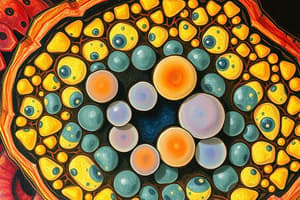Podcast
Questions and Answers
What is the primary function of the nucleus?
What is the primary function of the nucleus?
- Controlling cell growth, division, and heredity (correct)
- Breaking down and recycling cellular waste
- Generating energy for the cell
- Synthesizing proteins and lipids
Which organelle is responsible for modifying and packaging proteins and lipids for transport?
Which organelle is responsible for modifying and packaging proteins and lipids for transport?
- Lysosomes
- Golgi Apparatus (correct)
- Endoplasmic Reticulum (ER)
- Mitochondria
What is the primary function of the cell membrane?
What is the primary function of the cell membrane?
- Synthesizing proteins and lipids
- Breaking down and recycling cellular waste
- Generating energy for the cell
- Regulating what enters and leaves the cell (correct)
What is the composition of the cell membrane?
What is the composition of the cell membrane?
What is the function of lysosomes in the cell?
What is the function of lysosomes in the cell?
What is the role of the cytoskeleton in the cell?
What is the role of the cytoskeleton in the cell?
Match the organelles with their functions:
Match the organelles with their functions:
Match the organelles with their functions:
Match the organelles with their functions:
Match the organelles with their functions:
Match the organelles with their functions:
Match the organelles with their components:
Match the organelles with their components:
Match the organelles with their functions:
Match the organelles with their functions:
Match the organelles with their functions:
Match the organelles with their functions:
Flashcards are hidden until you start studying
Study Notes
Organelles
- Definition: Specialized structures within a cell that perform specific functions.
- Types:
- Nucleus: Controls cell growth, division, and heredity.
- Mitochondria: Generates energy for the cell through cellular respiration.
- Endoplasmic Reticulum (ER): Synthesizes proteins and lipids.
- Ribosomes: Site of protein synthesis.
- Lysosomes: Contains digestive enzymes that break down and recycle cellular waste.
- Golgi Apparatus: Modifies and packages proteins and lipids for transport.
- Cytoskeleton: Provides structural support, shape, and movement.
- Functions:
- Metabolic processes: Energy production, protein synthesis, and lipid synthesis.
- Cell signaling: Receives and responds to signals from outside the cell.
- Waste management: Breaks down and recycles cellular waste.
Cell Membrane
- Definition: A thin, semi-permeable membrane that surrounds the cell.
- Composition:
- Phospholipid bilayer: Two layers of phospholipid molecules with hydrophilic heads and hydrophobic tails.
- Proteins: Embedded in the membrane, facilitating transport, signaling, and cell-cell interactions.
- Functions:
- Regulation of what enters and leaves the cell: Controls the movement of molecules in and out of the cell.
- Cell signaling: Receives and responds to signals from outside the cell.
- Cell-cell interactions: Facilitates communication and adhesion between cells.
- Permeability:
- Selective permeability: Allows certain molecules to pass through while restricting others.
- Passive transport: Movement of molecules down their concentration gradient (diffusion, osmosis).
- Active transport: Movement of molecules against their concentration gradient, requiring energy.
Organelles
- Specialized structures within a cell that perform specific functions
- Types of organelles:
- Nucleus: controls cell growth, division, and heredity
- Mitochondria: generates energy for the cell through cellular respiration
- Endoplasmic Reticulum (ER): synthesizes proteins and lipids
- Ribosomes: site of protein synthesis
- Lysosomes: contains digestive enzymes that break down and recycle cellular waste
- Golgi Apparatus: modifies and packages proteins and lipids for transport
- Cytoskeleton: provides structural support, shape, and movement
Functions of Organelles
- Metabolic processes: energy production, protein synthesis, and lipid synthesis
- Cell signaling: receives and responds to signals from outside the cell
- Waste management: breaks down and recycles cellular waste
Cell Membrane
- Thin, semi-permeable membrane that surrounds the cell
- Composition:
- Phospholipid bilayer: two layers of phospholipid molecules with hydrophilic heads and hydrophobic tails
- Proteins: embedded in the membrane, facilitating transport, signaling, and cell-cell interactions
Functions of Cell Membrane
- Regulation of what enters and leaves the cell: controls the movement of molecules in and out of the cell
- Cell signaling: receives and responds to signals from outside the cell
- Cell-cell interactions: facilitates communication and adhesion between cells
Permeability of Cell Membrane
- Selective permeability: allows certain molecules to pass through while restricting others
- Types of transport:
- Passive transport: movement of molecules down their concentration gradient (diffusion, osmosis)
- Active transport: movement of molecules against their concentration gradient, requiring energy
Organelles and Their Functions
- Specialized structures within a cell that perform specific functions necessary for the cell's survival
Nucleus
- Controls cell growth and division
- Stores genetic information (DNA)
Mitochondria
- Generates energy for the cell through cellular respiration
Endoplasmic Reticulum (ER)
- Rough ER: involved in protein synthesis and transportation
- Smooth ER: involved in lipid synthesis and detoxification
Protein Synthesis
- Ribosomes: site of protein synthesis
Lysosomes
- Contains digestive enzymes
- Breaks down and recycles cellular waste and foreign substances
Golgi Apparatus
- Modifies and packages proteins and lipids for transport
Cytoskeleton
- Provides structural support, shape, and movement to the cell
- Microtubules: involved in cell division, transport, and maintenance of cell shape
- Microfilaments: involved in muscle contraction, cell movement, and maintenance of cell shape
- Intermediate Filaments: provides mechanical support and stability to the cell
Other Organelles
- Peroxisomes: involved in the breakdown of fatty acids and amino acids
- Centrioles: involved in the formation of cilia, flagella, and spindle fibers during cell division
- Chloroplasts (in plant cells only): site of photosynthesis, produces glucose and oxygen
- Vacuoles: stores water, salts, and other substances, helps maintain osmotic balance
Studying That Suits You
Use AI to generate personalized quizzes and flashcards to suit your learning preferences.




